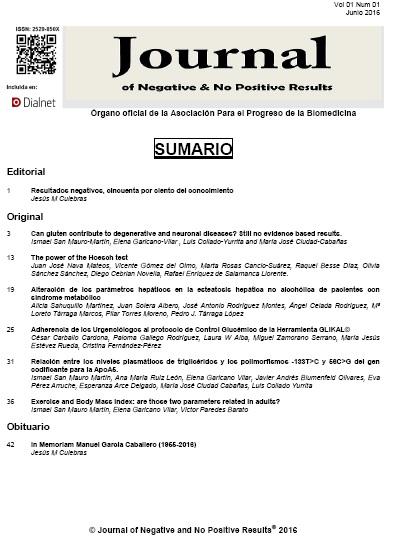The relation between plasmatic triglycerides levels and polymorphisms -133T>C and 56C>G of ApoA5 codifying gene.
DOI:
https://doi.org/10.19230/jonnpr.2016.1.1.932Keywords:
ApoA5, ApoA V, triglycerides, -113T>C, rs662799, 56C>G, rs3135506.Abstract
Aim. The aim was to evaluate the association between polymorphisms -113C>T (rs662799) and 56C>G (rs3135506) and plasmatic triglycerides levels in adults.
Methods. A randomized clinical trial of 44 subjects from two hospital centers from Madrid (Spain). Anthropometric survey, blood test, genetic analysis and an Ad hoc survey (lifestyle habits: nutrition, physical activity, sleep) were conducted.
Results. No statistically significant differences were observed between polymorphism 113G>T or 56C>G and plasmatic triglycerides concentrations (p>0.05). However, statistically significant differences were found between gene variant 56C>G and total cholesterol
levels and low-density lipoproteins (p=0.015 and p=0.036, respectively).
Conclusion. This trial brings to light no association between plasmatic triglycerides levels and polymorphic variants 56C>G and -1131T>C of Apo5 coding gene.
Downloads
References
Hegele RA, Ginsberg HN, Chapman MJ, Nordestgaard BG, Kuivenhoven JA, Averna M, et al; European
Atherosclerosis Society Consensus Panel. The polygenic nature of hypertriglyceridaemia: implications for definition,
diagnosis, and management. Lancet Diabetes Endocrinol. 2014;2(8):655-66.
WHO.int. Cardiovascular diseases [página Web]. [Fecha de actualización: 2015 ene; 2016 may 18]. Disponible en:
http://www.who.int/mediacentre/factsheets/fs317/en/
Nordestgaard BG, Varbo A. Triglycerides and cardiovascular disease. Lancet. 2014;384:626-35.
Pennacchio LA, Olivier M, Hubacek JA, Cohen JC, Cox DR, Fruchart JC, et al. An apolipoprotein influencing
triglycerides in humans and mice revealed by comparative sequencing. Science. 2001;294:169-73.
San Mauro-Martín I, de la Calle-de la Rosa L, Sanz-Rojo S, Garicano-Vilar E, Ciudad-Cabañas MJ, Collado-Yurita L.
Enfoque genómico en la enfermedad cardiovascular. Nutr HosP. 2016;33(1)148-55.
Li S, Hu B, Wang Y, Wu D, Jin L, Wang X. Influences of APOA5 variants on plasma triglyceride levels in Uyghur
population. PLoS One. 2014;9(10):e110258.
Portao J, Bescós R, Irurtia A, Cacciatori E, Vallejo L. Valoración de la grasa corporal en jóvenes físicamente activos:
antropometría vs bioimpedancia. Nutr Hosp. 2009;24:529-34.
Allain CC, Poon LS, Chan CS, Richmond W, Fu PC. Enzymatic determination of total serum cholesterol. Clin Chem.
;20(4):470-5.
Sugiuchi H, Uji Y, Okabe H, Irie T, Uekama K, Kayahara N, et al. Direct measurement of high-density lipoprotein
cholesterol in serum with polyethylene glycol-modified enzymes and sulfated alpha-cyclodextrin. Clin Chem.
;41(5):717-23.
Perk J, De Backer G, Gohlke H, Graham I, Reiner Z, Verschuren M, et al. European Guidelines on cardiovascular
disease prevention in clinical practice (version 2012). The Fifth Joint Task Force of the European Society of
Cardiology and Other Societies on Cardiovascular Disease Prevention in Clinical Practice (constituted by
representatives of nine societies and by invited experts). Eur Heart J. 2012;33(13):1635-701.
Guardiola M, Cofán M, de Castro-Oros I, Cenarro A, Plana N, Talmud PJ, et al. APOA5 variants predispose
hyperlipidemic patients to atherogenic dyslipidemia and subclinical atherosclerosis. Atherosclerosis. 2015;240(1):98-
Li S, Hu B, Wang Y, Wu D, Jin L, Wang X. Influences of APOA5 variants on plasma triglyceride levels in Uyghur
population. PLoS One. 2014;9(10):e110258.
Fallah MS, Sedaghatikhayat B, Guity K, Akbari F, Azizi F, Daneshpour MS. The relation between metabolic syndrome
risk factors and genetic variations of apolipoprotein V in relation with Serum triglyceride and HDL-C level. Arch Iran
Med. 2016;19(1):46-50.
Halalkhor S, Jalali F, Tilaki KH, Shojaei S. Association of two common polymorphisms of apolipoprotein A5 gene with
metabolic syndrome indicators in a North Iranian population, a cross-sectional study. J Diabetes Metab Disord.
;13:48.
Additional Files
Published
Issue
Section
License
All accepted originals remain the property of JONNPR. In the event of publication, the authors exclusively transfer their rights of reproduction, distribution, translation and public communication (by any sound, audiovisual or electronic medium or format) of their work. To do so, the authors shall sign a letter transferring these rights when sending the paper via the online manuscript management system.
The articles published in the journal are freely used under the terms of the Creative Commons BY NC SA license, therefore.
You are free to:
Share — copy and redistribute the material in any medium or format
Adapt — remix, transform, and build upon the material
The licensor cannot revoke these freedoms as long as you follow the license terms.
Under the following terms:
Attribution — You must give appropriate credit, provide a link to the license, and indicate if changes were made. You may do so in any reasonable manner, but not in any way that suggests the licensor endorses you or your use.
NonCommercial — You may not use the material for commercial purposes.
ShareAlike — If you remix, transform, or build upon the material, you must distribute your contributions under the same license as the original.
No additional restrictions — You may not apply legal terms or technological measures that legally restrict others from doing anything the license permits.

This work is licensed under a Creative Commons Attribution-NonCommercial-ShareAlike 4.0 International License

























